< Previous | Contents | Next >
Tale of a Pulpit
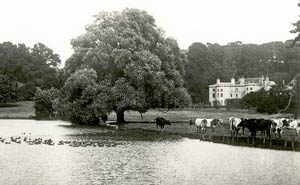
Kirklington Hall in the 1930s.
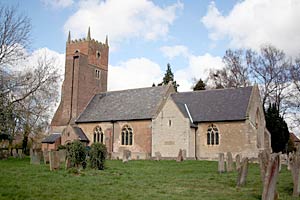
Kirklington church in 2006.
© Copyright Richard Croft and licensed for reuse under this Creative Commons Licence
KIRKLINGTON. At one end of this pleasant patch in the green countryside between Newark and Mansfield is a charming scene where the little River Greet comes under the road from the fine millpool; at the other, lofty trees shade a lovely bit of road climbing toward Hockerton. The great house, an 18th century building modernised, stands in a park with a fine lake.
Though the church has small claim to beauty, it has a few old remains, two treasures, and a story. Some of the old stone is left in the brick tower, the hood of the south porch has heads of a king and a queen, and at the north door are two old faces amusing for their contrast, one a very fat man and one very lean. A lovely window in the chancel has most of its original 14th century work.
One of the church's two treasures is the fine 12th century font, carved with a band of four-leaved ornament and interlaced arcading; the other is an ancient stone built into an outside wall, four feet long and perhaps as old as the font. Within a border are stars, zigzag, and nine round bosses in a block, and on one end of the stone is a sundial.
The village story here is of a wooden pulpit we do not see, for it has been carried out of the church for the last time. The story is that early last century the vicar used to take the pulpit from its base and carry it to a swamp, where he used it as a screen for wild duck shooting. The holes through which he fired were filled up and the pulpit continued in use, but there have been no more vandal parsons of Kirklington, shooting ducks on Monday from the pulpit they preached from on Sunday. Now there is a stone pulpit.
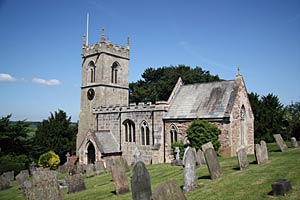
Kirton church in 2010.
© Copyright Richard Croft and licensed for reuse under this Creative Commons Licence
KIRTON. It has little to show but a neat old church high above the road, looking over the housetops to a landscape bounded by the green depths of the Forest. Steps climb up to the churchyard, which goes on climbing higher still among fine trees.
The 500-year-old tower has a pyramid cap. From the 13th century come the north doorway with two worn heads, a window close by with two smiling faces, the chancel arch, and the fine little nave arcade of three bays, with stone seats round the pillars. Several windows come from the next two centuries, and there are a few old glass fragments.
Two treasures of the church are a splendid 14th century chest and a slender 16th century pillar almsbox stoutly bound with ironwork. The oldest relic is the small round bowl of a Norman font, long in the churchyard and now sheltered in the porch.
The Thirteen Chestnut Trees
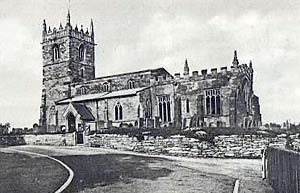
Kneesall church in the 1930s.
KNEESALL. Set high on a little ridge, with winding ways and lovely trees, it looks out on a green and pleasant land. A fine array of 13 great horse-chestnuts in the churchyard overhang the road, their beauty seen inside the church through the plain glass windows. The splendid 15th century tower has a striking parapet of pointed battlements and pinnacles like a crown, and between grotesque gargoyles at the corners is an angel on every side. Two smiling faces adorn the west window. The most remarkable of the huge gargoyles outside the nave has two figures with tiny bodies and huge heads, one sitting and one kneeling as they crouch close together. Their heads are touching, and they are looking out with wide eyes and eager expression, as if singing.
The south doorway comes from the close of the 13th century, when the tower arch was shaped; the nave arcades (with stone seats round the pillars and heads of human folk on the arches) are about 1400, as are the clerestory windows above them. Old lancets and fine 15th century windows light the chancel. A small old oak chest was given by the parents of two brothers who did not come back from the war. Eleven oak benches with traceried ends and worn poppyheads are 500 years old (with seats restored) an altar table is Jacobean, the font is old, and old woodwork remains in the roofs. A much-valued possession is a fragment of an 11th century cross, 20 inches high and carved with knotwork. It was found in the tower wall.
The Watcher on the Hill
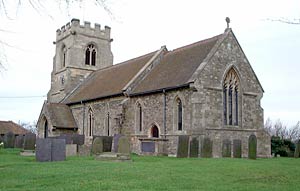
Kneeton church in 2004.
© Copyright Dave Kelly and licensed for reuse under this Creative Commons Licence
KNEETON. On the top of a steep wooded cliff overhanging the Trent, braving all the winds that blow, is its little gathering of houses and farms with a tiny church.
Thousands know the red-roofed barns and the grey church that stands like a watcher on the hill when seen from Hoveringham across the river. Not so many know it for itself perhaps, for its magnificent view of the river winding like a serpent, and of the valley beyond, where trains look like toys as they pass. From the ravine going down to the river there are lovely walks among the trees, with delightful glimpses of the stream.
Four ugly gargoyles, half human, have been looking out from the battlemented tower for five centuries. The font is 13th century. A medieval arcade is seen in the nave wall outside.
